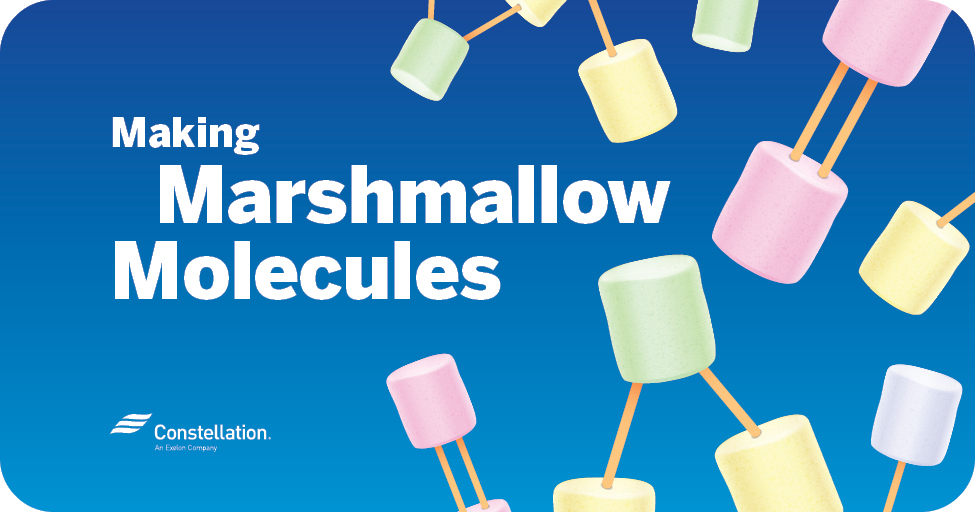
- Category:
Uncategorized -
Last updated:
April 9, 2021
Making Marshmallow Molecules
What You’ll Need:
- Multi-color mini-marshmallows
- Four Ziploc bags or plastic bowls
- Toothpicks
- Marshmallow Molecule Cards
- Card Stock
- Glue
- Marker or sharpie
- Scissors
How to Do the Experiment:
- Most multi-color mini-marshmallows come in four colors. Separate each color and place them in a bag or a bowl. Each color will represent a different element – Oxygen (O), Carbon (C), Hydrogen (H) and Nitrogen (N). You can decide which color is which element but stay consistent. It helps to label the bag or bowl – for example if you decide your orange marshmallows are Oxygen write Oxygen (O) on the bag. Do the same with the other three colors.
- Download or print the Marshmallow Molecule Cards
- Choose a molecule you would like to make. Look at it carefully. Select the proper elements and make the molecule. The lines connecting the molecules on the cards are covalent bonds. One line is a single bond and two lines is a double bond. Depending on single or double covalence that is how many toothpicks you will use. As the molecules become more complex, you might want to cut the toothpicks in half for space.
- If you have card stock and glue go ahead and glue your molecules down. Write the name of the molecule on the top of your paper and share what you have made!
What’s Happening?
- Simply put, chemistry is the science of changes in matter. Matter is anything that has mass and takes up space. The smallest functional unit of matter that we know of is the atom – atoms are the smallest component of all the known elements, share common characteristics with the elements that they are a part of, and are made of subatomic particles known as protons and neutrons within a nucleus and electrons found in expanding shells around the nucleus.
- Elements are substances that cannot be broken down into simpler substances. If you have a canister of oxygen, you can break out all the individual oxygen atoms but nothing more. The most common element in the universe, hydrogen, makes up 75 percent of all matter. Helium accounts for 24 percent of matter. That means all the other 116 known elements only make up 1 percent of the universe.
- Molecules are a group of elements (atoms) bonded together which represent the smallest fundamental unit of a chemical compound that can take place in a chemical reaction.
- So chemistry is the interaction between different elements and molecules and the changes they cause. One of the simplest molecules is water (H2O). Water is two hydrogen atoms covalently bonded to a single oxygen atom.
- A covalent bond involves the sharing of electron pairs between different atoms. Water goes through changes that no other molecule on Earth goes through. It can be found in liquid, solid and gaseous states. These changes of state is the simplest example of chemistry.
As you make your molecules, try to find patterns between bonds to better understand how certain elements interact with one another. Pay attention to the names of molecules as well.
Jason Hammond is the A’STEAM manager at the Children’s Museum Houston. A’STEAM (Afterschool Science, Technology, Engineering, Arts Design, Mathematics) is a program developed in partnership with the YMCA of Greater Houston to provide weekly science activities to after school children throughout the Houston area and beyond. During the summer the partnership continues with Summer of Learning – a program that provides weekly science activities to children enrolled in YMCA summer camps. Jason and his team at the Children’s Museum also create activities for YMCA summer camps at Camp Cullen, Girl Scouts of San Jacinto and Camp Adventure, a summer camp program for Houston’s disadvantaged youth.
During the stay at home order, Jason has been busy providing educator moments and story times that can be seen on the Children’s Museum Houston Instagram, Facebook and YouTube channels, providing updated curriculum for the Children’s Museum web page, creating daily fun activities for families that have limited access to internet, and overseeing the creation of science kits for centers providing day care services to essential workers and science bags for individual families.




